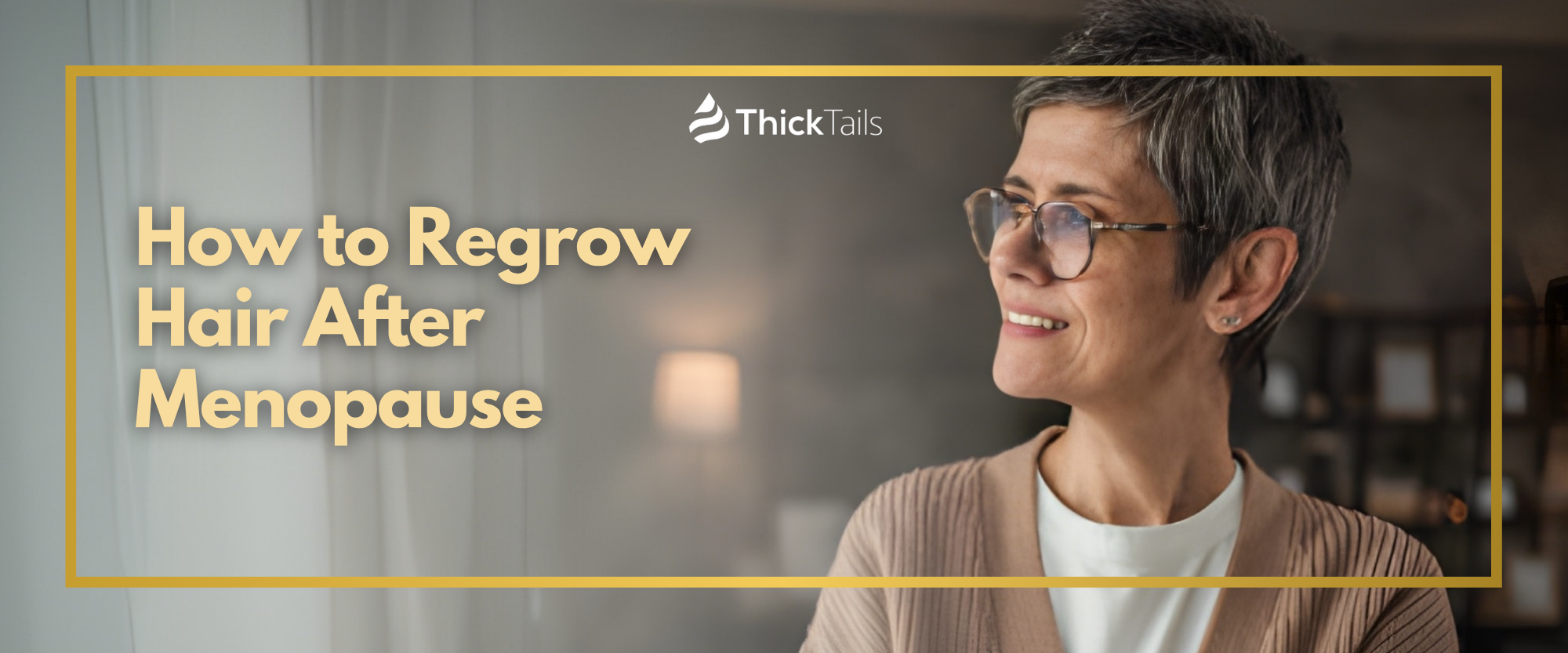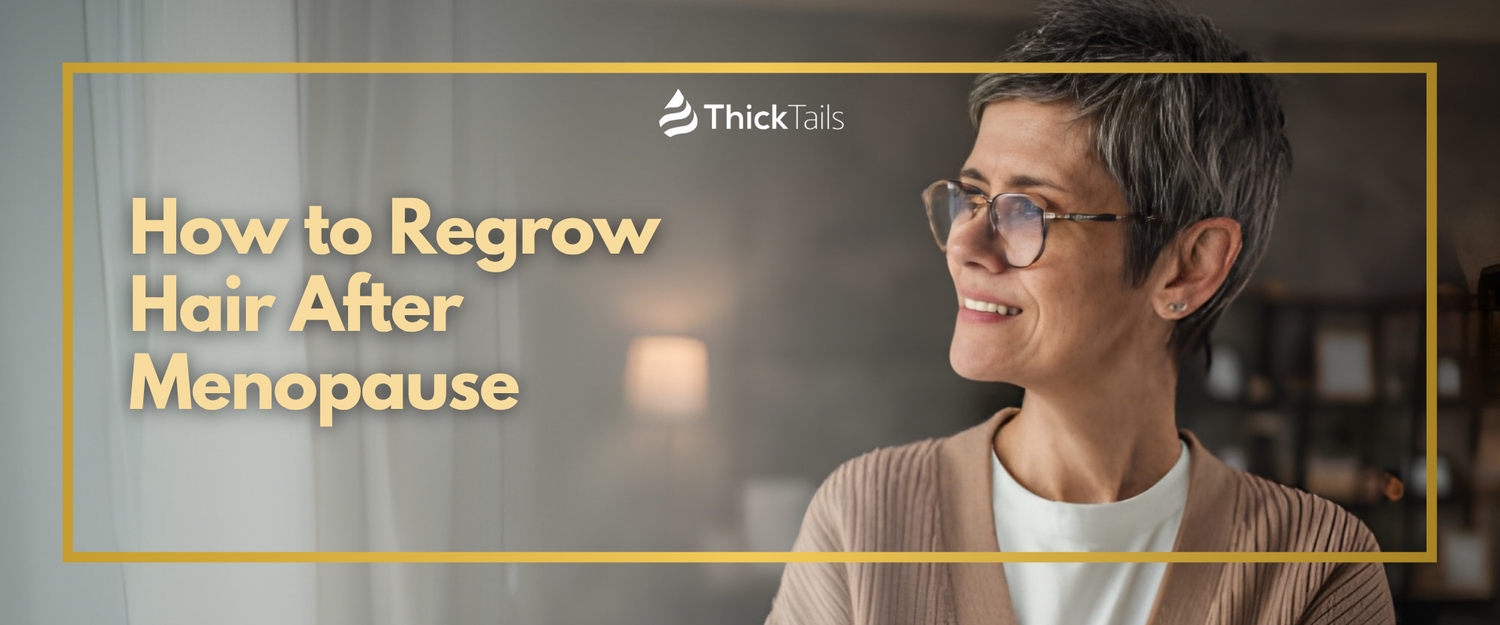Understanding Oestrogen Decline, Follicle Response, and Natural DHT Management
Many women notice their hair becoming thinner, weaker, or less voluminous after menopause. While this can be a frustrating experience, it’s also one that’s entirely natural and manageable with the right knowledge and care. Learning how to regrow hair after menopause begins with understanding what’s happening inside the body—specifically, how hormonal shifts influence the scalp and follicles—and using natural remedies to restore balance and vitality.

1. Why Hair Changes After Menopause
During menopause, oestrogen and progesterone levels fall significantly. These hormones not only regulate reproductive functions but also play a vital role in maintaining healthy hair growth. Oestrogen, in particular, helps to prolong the anagen (growth) phase of the hair cycle, meaning more strands stay actively growing for longer.
When oestrogen levels drop, the balance shifts in favour of androgens—male hormones that women also produce in smaller amounts. The most potent of these is DHT (dihydrotestosterone), which can shrink hair follicles, shorten the growth phase, and lead to a gradual thinning of hair, particularly around the crown and hairline.
The result? Hair appears finer, more brittle, and less dense. Fortunately, this process can be slowed—and in many cases, reversed—with natural approaches that support both the scalp and the hormonal environment.
2. The Role of DHT in Menopausal Hair Thinning
Understanding DHT is essential when learning how to regrow hair after menopause. DHT binds to receptors in hair follicles, causing them to miniaturise over time. This means new hair strands become thinner and weaker until they eventually stop growing altogether.
The key to encouraging regrowth is to naturally reduce the effects of DHT without interfering with the body’s essential hormonal functions. Certain botanical extracts and vitamins can gently modulate DHT activity while nourishing follicles and promoting a healthy scalp environment.
3. Natural Ingredients That Support Hair Regrowth After Menopause
Modern hair science increasingly focuses on nature-based solutions that work in harmony with hormonal changes. Below are some of the most effective ingredients proven to help with post-menopausal hair recovery.
Saw Palmetto Extract
One of the most recognised natural DHT blockers, saw palmetto works by inhibiting the enzyme 5-alpha reductase, which converts testosterone into DHT. This helps reduce follicle miniaturisation, supporting thicker, stronger hair regrowth over time.
Ingredient callout: ThickTails Hair Growth Serum and Shampoo both include saw palmetto to help protect against hormone-related hair thinning.
Caffeine Extract
Topical caffeine energises hair follicles and counteracts the suppressive effects of DHT. It stimulates scalp circulation, extending the growth phase and encouraging denser regrowth. Unlike harsh medical treatments, caffeine works gently and effectively, making it suitable for long-term, consistent use.
Niacin (Vitamin B3)
Known for improving microcirculation, niacin enhances the delivery of oxygen and nutrients to hair follicles. Better blood flow supports healthy follicle metabolism, leading to stronger and more resilient new strands.
Biotin (Vitamin B7)
Biotin is a cornerstone of healthy hair structure. It aids in keratin production—the key protein that forms hair fibres—and helps reduce breakage while improving shine and elasticity.
Amino Acids and Peptides
As we age, hair can lose its structural integrity. Amino acids replenish the hair’s protein composition, while peptides reinforce the bond between hair and scalp, helping to maintain volume and thickness.
4. Restoring Balance: The Scalp as the Foundation of Regrowth
The scalp often mirrors internal changes during menopause. Reduced oestrogen can lead to dryness, sensitivity, and reduced natural sebum production. Supporting scalp health is therefore crucial when addressing how to regrow hair after menopause.
Gentle Exfoliation
Light exfoliation removes product build-up and dead skin cells, allowing treatments to penetrate more effectively. It also stimulates blood flow to dormant follicles.
Moisturising with Natural Oils
Ingredients such as argan oil, jojoba oil, and vitamin E restore hydration to the scalp without clogging pores. A balanced, nourished scalp creates the ideal environment for regrowth.
Panthenol (Pro-Vitamin B5)
Panthenol helps to retain moisture in both scalp and hair fibres, improving texture, smoothness, and elasticity—especially important for brittle, post-menopausal strands.
5. Supporting Hormone Health Naturally
While topical treatments are vital, internal support plays an equally important role in post-menopausal hair recovery. Since oestrogen and progesterone levels decline, it’s beneficial to nourish your body with foods and nutrients that promote hormonal balance.
Nutrient Support for Hair and Hormones
-
Omega-3 fatty acids (from salmon, flaxseed, and walnuts) support scalp hydration and cell renewal.
-
Iron-rich foods such as spinach and lentils improve oxygen delivery to hair roots.
-
Zinc and selenium help regulate follicle activity and repair.
-
Phytoestrogen-rich foods like soy, chickpeas, and flaxseed may gently mimic the effects of oestrogen in the body.
Lifestyle Factors
Chronic stress and poor sleep can exacerbate hormonal imbalance and increase hair shedding. Prioritising rest, managing stress, and incorporating relaxation techniques such as yoga or meditation can all contribute to better hormonal harmony—and by extension, healthier hair.

6. Building a Consistent Hair Regrowth Routine
The process of regrowing hair after menopause requires patience and consistency. Hair growth follows a slow cycle, and most people notice visible improvements within three to six months of continuous care.
A simple daily routine might include:
-
Cleanse gently with a sulphate-free shampoo that contains caffeine, saw palmetto, and niacin to stimulate the scalp.
-
Condition and fortify using a nutrient-rich conditioner with biotin, panthenol, and peptides.
-
Apply a topical serum directly to the scalp daily to deliver concentrated active ingredients that encourage regrowth.
-
Massage the scalp for two to three minutes to boost circulation and absorption.
Soft CTA: The ThickTails Hair Growth Range has been formulated specifically for women experiencing hair loss due to hormonal changes—whether during postpartum recovery or menopause. Each product is free from SLS, sulphates, and parabens, and never tested on animals. Used together, they help nourish follicles, rebalance the scalp, and encourage natural regrowth.
7. The 90-Day Regrowth Commitment
Just as it takes time for hormones to fluctuate during menopause, it takes time for the hair growth cycle to respond to treatment. For this reason, it’s recommended to use a targeted regimen for at least 90 days to see optimal results.
With a 100% money-back guarantee, ThickTails encourages women to commit to this natural process without worry—providing complete confidence as you nurture your hair back to fullness.
Conclusion: Embracing Renewal After Menopause
Hair loss after menopause can feel discouraging, but it’s far from irreversible. By understanding the role of oestrogen decline, follicle sensitivity, and DHT activity, you can take proactive steps to restore balance and strength to your hair.
Through consistent care, nutrient support, and the use of natural, hormone-friendly ingredients, regrowth becomes entirely achievable. The journey towards healthier, fuller hair after menopause is about more than appearance—it’s a celebration of renewal and self-care at every stage of life.





